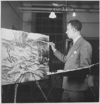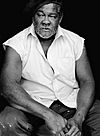Gesture facts for kids

A gesture is a form of nonverbal communication. Unlike verbal communication, which uses words, gestures use movements of the body.
Gestures are deliberate acts with a purpose, not just any movements. They are handled in the human brain by the same centres which handle language. In the neocortex, Broca's and Wernicke's areas, are used by speech and sign language.
Other movements of the body have meaning, but are not gestures. They may be done by actors deliberately, but normally they are automatic, unconscious signals which express various feelings or states of mind. Many animals communicate extensively using such behaviours. The dog, a companion to humans for a long time, is good at reading both gestures and behaviours. Multi-touch computers have been made to read gestures.
Gestures have a cultural significance (meaning). The same gesture can mean different things in different cultures and different parts of the world.
Examples
- High five – a greeting or sign of happiness
- Facepalm – showing frustration
- Sign of the cross – religious gesture
- V sign – victory or peace sign
Anti-examples
These are not gestures, because they are not voluntary, deliberate actions. They are inherited automatic reactions or reflexes.
- Screaming out in great pain or terror.
- Baring our teeth in anger
- Cowering, turning the face away and running in terror.
- Many behaviours of babies, such as suckling on nipples.
Humans can modify these reactions to some extent with training and practice, but they are fundamentally caused by hormones and brain centres which are very ancient.
Related pages
Images for kids
See also
 In Spanish: Gesto para niños
In Spanish: Gesto para niños
 | Sharif Bey |
 | Hale Woodruff |
 | Richmond Barthé |
 | Purvis Young |


